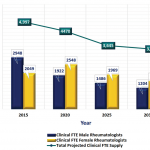(Reuters Health)—A growing number of patients are seeking care from rheumatologists for chronic health problems like arthritis, back pain and osteoporosis, just as the supply of specialists is shrinking, two new studies suggest.
An estimated 6,013 clinicians in the U.S. specialized in rheumatology as of 2015, the equivalent of 5,415 full-time providers, according to one of the studies, published online February 5 in Arthritis Care & Research. By 2030, that’s projected to fall to 4,882 clinicians, or the equivalent of just 4,051 full-time providers.
“During this same time period the adult patient demand for doctor diagnosed arthritis care is expected to increase by over 25%,” said Dr. Daniel Battafarano, program director of the rheumatology fellowship at Brooke Army Medical Center in San Antonio, Texas, and a professor at the Uniformed Services University of the Health Sciences.
It will be significantly harder for adult patients to get access to rheumatologists, “since the demand for care will clearly be higher than the supply of rheumatologists in the U.S.,” Battafarano, an author on both studies, said by email.
As of 2015, patient demand already exceeded clinician supply by the equivalent of 700 full-time providers. By 2030, patient demand is expected to exceed clinician supply by the equivalent of 4,133 full-time providers, the study found.
Part of this trend is happening as aging Baby Boomers are increasingly seeking care from specialists for a variety of ailments that can develop and worsen with age.
At the same time, the shortage is being worsened by retirements among aging Baby Boomer clinicians, and an increase in millennial, female, and part-time providers who aren’t putting in the same hours that were seen in this specialty a generation ago when it was predominantly male.
A new generation of clinicians also isn’t filling available training programs in rheumatology, according to the other study, published in Arthritis & Rheumatology.
As of 2015, there were 113 adult rheumatology training programs with 431 of 468 available positions filled, and this was projected to produce the equivalent of 107 new full-time providers entering the workforce each year.
Millennials make up 6% of the current workforce, but will constitute 44% by 2030, researchers projected. Similarly, men make up 59% of the current workforce but will account for just 43% of providers by 2030.
Some previous research suggests that Millennials see fewer patients and that women tend to work fewer hours, which may lead to a decline in the number of full-time providers available to meet rising patient demand.


